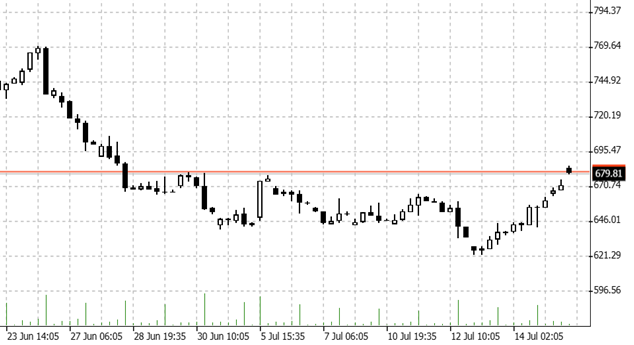

17.07.2023 – Once again we have to deal with the wheat crisis. Because today the export agreement between Ukraine and Russia expires. Whether there will be an extension this time is open, because Moscow is blocking. And then there is the latest report of the US Department of Agriculture on the world market.
Lively ups and downs in wheat: first the United States Department of Agriculture sank the price last Wednesday. Here is the four-hour chart of the September contract in cents per bushel. And then it went north because Russia’s President Vladimir Putin blocked. There had been such threats time and again. But how will it end this time?

Source: Bernstein Bank GmbH
Wheat for the world
The “Frankfurter Allgemeine Zeitung”, however, judged that the whole world would be affected if the agreement were to be terminated. That’s because, according to UN data, some 32.9 million tons of grain had been exported since the agreement was concluded last July, 725,000 tons of it by the World Food Program (WFP) for underdeveloped countries such as Ethiopia, Somalia or Yemen. That was more than half of the grain shipped by WFP in 2022, he said – making the importance of the corridor abruptly clear. We are curious to see how the political tug-of-war will develop. What is already clear is that many fields near the front lines in Ukraine will not be harvested, and that this will reduce the harvest.
Bearish WASDE report
And with that, we look at global supply. Last Wednesday, USDA had its say with the World Agricultural Supply and Demand Estimates (WASDE). The agency raised its estimate for global wheat production volume for the 2022/23 season to 790.20 million tons. The volume in the 2021/23 season had been 781.05 million tons. It also said exports would increase from 202.85 million tons to 217.17 million tons. It added: “The projected season-average farm price is forecast at $7.50 per bushel, down $0.20 from last month.”
Barchart.com commented: “The July WASDE report hit the agricultural sector like a ton of bricks.” But the website still remained bullish: “The kneejerk selling in the soybean, corn, and wheat futures market turned out to be a mistake, and the bearish tone of the July WASDE report provided market participants that bought the dip with a gift.” The arguments: Drought in the Northern Hemisphere; rising production costs added to the product; and just the war in Ukraine. In addition, USDA tends to traditionally give a best-case scenario. At least with regard to the influencing factor of the Ukraine war, Barchart has been proven right for the time being. We are curious to see how the matter develops – we will keep you up to date!
_______________________________________________________________________________________________________________________________
The content of this publication is for general information purposes only. In this context, it is neither an individual investment recommendation or advice nor an offer to purchase or sell securities or other financial products. The content in question and all the information contained therein do not in any way replace individual investor- or investment-oriented advice. No reliable forecast or indication for the future is possible with respect to any presentation or information on the present or past performance of the relevant underlying assets. All information and data presented in this publication are based on reliable sources. However, Bernstein Bank does not guarantee that the information and data contained in this publication is up-to-date, correct and complete. Securities traded on the financial markets are subject to price fluctuations. A contract for difference (CFD) is also a financial instrument with leverage effect. Against this backdrop, CFD trading involves a high risk up to the point of total loss and may not be suitable for all investors. Therefore, make sure that you have fully understood all the correlating risks. If necessary, ask for independent advice. CFDs are complex instruments and are associated with the high risk of losing money quickly because of the leverage effect. 68% of retail investor accounts lose money trading CFD with this provider. You should consider whether you understand how CFD work and whether you can afford to take the high risk of losing your money.7
